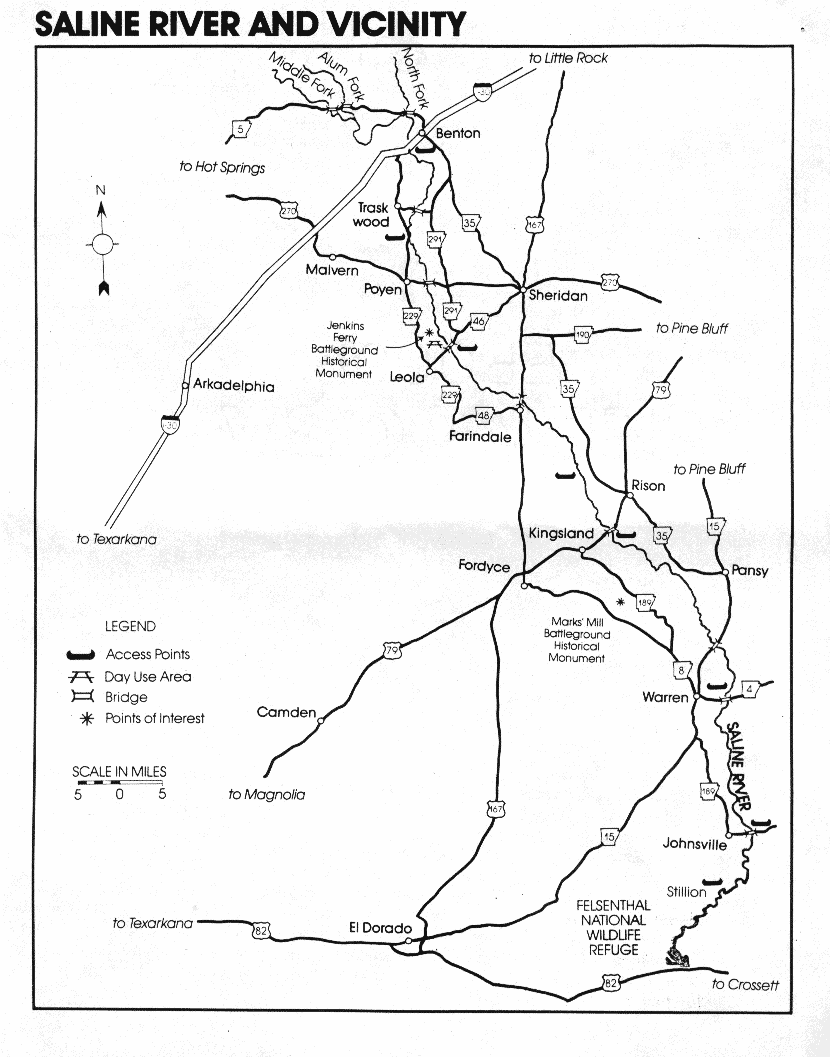Saline River

Saline River map
The Saline River maintains the
intangible quality of timelessness. Born of the rivulets that
flow out of the eastern foothills of
the rugged Ouachita Mountains,
its three major divisions, Middle, Alum and North forks,
merge above Benton. Below this
point the river flattens out to begin its long journey through
Grant, Cleveland, Bradley and
Ashley counties to its confluence
with the Ouachita River in the
heart of Felsenthal National
Wildlife Refuge.
The Saline River is the last major undammed stream in the entire Ouachita Mountain drainage,
and its watershed contains some
of the finest deer, turkey and
squirrel hunting in Arkansas.
That, combined with the excellent fishing, scenery and backcountry floating the river produces, makes it no wonder that
Arkansans who know it regard
the river with almost fanatical devotion.
SECTION DESCRIBED
Source to Ouachita River, a distance of 204 river miles.
CHARACTERISTICS
The upper portion of the Saline,
above Benton, is characterized as
a clear, cold-water section with a
series of fast-running shoals interspersed with short, quiet
pools. The middle section of the
river (Benton to Warren) contains
long pools and few riffles with
clear to murky water. The river's
lower section below Warren has
sluggish current with slightly
murky water. The Saline is one of
only a few rivers that has a gravel
bottom throughout its entire
length.
SEASONS
The Saline is a good year-round
float stream except in the uppermost portions.
ACCESS POINTS
Access to the Saline is generally
at state highway crossings, county road crossings and numerous
little-known fords and ferry sites.
The Game and Fish Commission
has developed several access
points along the river, including
(working downstream): a boat
ramp off Highway 229 on a forest
road between Traskwood and
Poyen; Lee's Ferry Access from
Highway 35: Pool access at
Highway 79: Mt. Elba off Highway 35; Highway 4 out of Warren: at Longview off Highway
189 between Fountain Hill and
Johnsville; and Stillion at the
mouth of the canal right below
Lake Georgia Pacific. There is
also access in Grant County at
Jenkins' Ferry Historical Monument between Sheridan and
Leola. Local inquiry will generally uncover others on or near forest roads.
SCENERY
The Saline remains relatively unspoiled by man and creates an illusion of wilderness along much
of its length. Dense forests line
the river banks. Visitors may be
treated to the sight of deer, mink,
otters, beaver, muskrats and a variety of bird species.
The Saline is one of the most underrated fishing rivers in Arkansas. Smallmouth bass abound in
the upper reaches: largemouth
bass occupy the lower reaches:
and the intermediate water be-
tween has a healthy population of
spotted bass that overlaps into
both areas. The warmouth, longear, and green sunfish top the
panfish offering, with some bluegills and crappie. The river also
has a good walleye fishery, and
channel catfish are common.
Rock bass are found in association with smallmouth bass on the
upper third of the river.
Fishing during much of the
year is a "wade a little, fish a
little" proposition, and for this
reason, canoes are much preferred over the traditional flatbottom johnboat. A motor is normally more trouble than it' s
worth on headwater float trips,
though a light electric trolling
motor can be a real boon at times.
SERVICES AVAILABLE
Gas, groceries, restaurants and
overnight accommodations are
available in nearby communities.
Picnicking and swimming are
available at Jenkins' Ferry Historical Monument south of Sheridan.
OTHER INFORMATION
The best time to float the Saline is
when it's low and clear. When the
current is swift, logjams, brushpiles and uprooted trees can make
even travel difficult in some
areas.

ARKANSAS RIVERS & CREEKS
Big Piney Creek
Buffalo River
Caddo River
Cadron Creek
Cossatot River
Crooked Creek
Eleven Point River
Illinois Bayou
Kings River
Little Missouri River
Little Red River
Mulberry River
Ouachita River
Saline River
Spring River
Strawberry River
White River



![[CleanWeb Approved Site]](cwlogo.gif)
This page hosted by  Get your own Free Home Page
Get your own Free Home Page
© 1997, 1998 arkoutdoors




![[CleanWeb Approved Site]](cwlogo.gif)
 Get your own Free Home Page
Get your own Free Home Page
